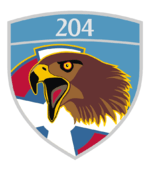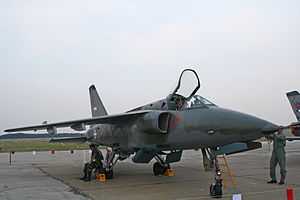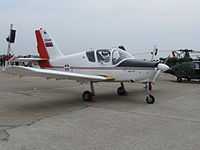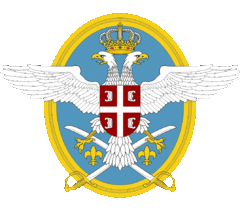Serbian Air Force and Air Defence
| Serbian Air Force and Air Defence | |
|---|---|
|
Serbian Air Force Coat of Arms | |
| Active |
1912–1918 2006–present |
| Country | Serbia |
| Allegiance | President of Serbia |
| Type | Air Force |
| Size |
4,000 personnel 142 aircraft |
| Part of | Serbian Armed Forces |
| Headquarters | Air Force Command, Zemun |
| Motto |
"За слободу и част Отаџбине" "For Freedom and Honor of the Fatherland" |
| Anniversaries | 24 December |
| Engagements | Operation Allied Force |
| Commanders | |
| Commander | Major general Ranko Živak |
| Insignia | |
| Roundel |
 .svg.png) |
| Aircraft flown | |
| Attack | J-22, G-4, |
| Fighter | MiG-29, MiG-21bis |
| Helicopter | Mi-8, Mi-17 |
| Attack helicopter | HN-42M GAMA, HN-45M GAMA |
| Utility helicopter | HO-42, HO-45 |
| Interceptor | MiG-21bis |
| Reconnaissance | INJ-22 , MiG-21M, MiG-21bis modified, HI-42 HERA |
| Trainer | Utva 75, Lasta 95, G-4, NJ-22 |
| Transport | An-2, An-26, Yak-40 |
The Serbian Air Force and Air Defence (Serbian: Ваздухопловство и противваздушна одбрана / Vazduhoplovstvo i protivvazdušna odbrana), is the air force of Serbia and service branch of the Serbian Armed Forces. Established on 24 December 1912 in the city of Niš,[1] it was absorbed into the various Yugoslav Air Forces between 1918 and 2006.
History

The first aviation pioneer in Serbia was major Kosta Miletić (1874-1953), trained as a balloon pilot at the Technical Aeronautical School near Saint Petersburg, Russia from 14 February 1901 to 12 November 1902,[3] Miletić was also trained in the use of carrier pigeons.
On the recommendation of Miletić, the Serbian armed forces posed messenger pigeon stations (in 1908 in Medosevac near Nis and in 1909 in Pirot), and bought two free spherical and one tied kite – balloon from the "August Ridinger" company from Augsburg. At the reception ceremony, on 19 April 1909, Kosta Miletić flew a spherical balloon called Srbija (Serbia). One balloon was provided from Russia. A gas chamber was ordered from the Dillmann company in Berlin, and a field winch from St Petersburg. A hydrogen unit was provided from the Swiss company Oerlikon. The equipment was delivered to Serbia in 1909 and 1910.
The first competition for cadet airmen in Serbia was opened on May 1911, and in the following year the First class of Serbian pilots started their flying training in France from 21 May – 8 September 1912 and got the rank of pilot. They finished the course in the beginning of the First Balkan War with aircraft and the balloons that had already been obtained prior to the outbreak of war.[4] In the autumn of 1912, Serbia got the aircraft for its armed forces. On 24 December 1912 the head of the military Ministry Radomir Putnik approved the formation of the Aviation Command situated in Niš; the commander was major Kosta Miletić. It comprised: the Aircraft Squadron which counted 12 military aircraft, the Balloon squad, the Pigeon post and the Base. This date is regarded in Serbia as marking the official founding of the air force. This made Serbia, one of the first 15 states in the world to have an air force. The Serbian Aviation Command's first combat experience occurred in March 1913 over the Skadar. On the first combat flight sergeant-pilot Mihajlo Petrović was killed, the second pilot to be killed in air combat in history. The first recorded fatality was a Bulgarian pilot, Topradzijev, who was killed in 1912 when he was flying back from a reconnaissance mission over Edirne (See also:Battle of Adrianople (1913)). Mihajlo Petrović was the first trained Serbian airplane pilot. He completed his training and exams at the famous Farman pilot school in France and was awarded the international FAI license no.979 in June 1912. His Serbian pilot's license carries the number 1.[3]
World War I
Serbian Air Force at beginning of World War I had 4 planes,2 balloons and 6 pilots,who had experience already from Balkan Wars.First operations started already during Battle of Kolubara.The first heavy gun equipped plane was Oluj and seen first operations in early 1915.Serbia already had 12 planes. In November 1915. Serbaian Air Force, made first transport of wounded soldiers from Serbia through Albania to Corfu.That was the first Medevac operation in air history [5] In 1916, Serbian Air Forces conducted over 3.000 sorties mostly on Salonika Front.
NATO bombing of Yugoslavia
An important portion of the 1999 war between Yugoslavia and the NATO coalition involved combat between the Yugoslav Air Force, which was the predecessor of today's Serbian Air Force, and the opposing air forces of NATO. United States Air Force F-15s and F-16s flying mainly from Italian air force bases attacked the defending Yugoslav fighters—usually MiG-29s, which were in bad shape, due to lack of spare parts and maintenance. A total of six Yugoslav MiG-29s were shot down in 1999, of which three were shot down by USAF F-15s, one by a USAF F-16, and one by a RNAF F-16.[6] One aircraft, according to a Serbian documentary, was hit by friendly fire from the ground.[7] Another four were destroyed on the ground.[8] During the course of the air war, Yugoslav anti-aircraft defenses downed a USAF F-16C and an F-117 Nighthawk, the first stealth aircraft to ever be shot down in combat.[9]
Role
- Maintaining airspace dominance.
- Intercepting and eliminating airspace violators.
- Providing air support and transport for terrestrial units.
- Responding to natural disasters.
Equipment
Aircraft
The air force fleet consists of several Soviet combat aircraft, consisting of a number of MiG-21s, and MiG-29s. Serbia is looking to replace its aging fleet with new multi-role combat aircraft. Before its demise, the former Yugoslav Air Force was developing the Novi Avion project which was intended as a replacement. The project was canceled in 1991 due to the collapse of Yugoslavia.
Serbia, as the largest succeeding nation of Yugoslavia, took possession of the entire Yugoslav Air Force inventory. After the Agreement on Sub-Regional Arms Control was enacted in 1996, dozens of J-22, J-21 and G-2s have been withdrawn from service.
The air force operates from three major air bases, the 204th Batajnica Air Base and 98th Lađevci Air Base and Niš Air Base.
Air Defence
The Serbian air force operates a variety of Soviet surface-to-air missile systems. Many are long-range with a moderate amount of short-range weapons assigned to infantry units. The 250th Air Defence Missile Brigade operates SA-3 and SA-6 surface-to-air missile systems. The military is upgrading both types with fire-and-forget ability. The air force has upgraded "Neva-M" to the "Neva-M1T" standard and "Kub-M" to "Kub-M2".[10][11][12] For defending air bases and important infrastructures Bofors 40mm L-70 in complement with M-85 Zirafa radars are used, and for engaging low flight targets 9K38 Igla or SA-18.
Radars
- S-605/654 Observation radars
- S-613 Altitude measurement radar
- AN/TPS-70 3D radar
- AS-74 and AS-84 automatized systems
Organization

- Air Force and Air Defence Command
-
 210th Signal Battalion
210th Signal Battalion -
 333rd Engineering Battalion
333rd Engineering Battalion - Air Medical Institute
- Moma Stanojlovic Aeronautical plant
- Section for Air Control, Protection and Allocation
-
-
 204th Air Brigade Batajnica Air Base
204th Air Brigade Batajnica Air Base
-
 101st Fighter Squadron
101st Fighter Squadron -
 252nd Training Squadron
252nd Training Squadron -
 138th Transport Squadron
138th Transport Squadron -
 890th Mixed Helicopter Squadron
890th Mixed Helicopter Squadron - 24th Air Technical Battalion
- 17th Airfield Security Battalion
- 177th Air Defence Artillery Missile Battalion
-
-
 98th Air Brigade Kraljevo-Lađevci Airport
98th Air Brigade Kraljevo-Lađevci Airport
-
 241st Fighter-Bomber Squadron
241st Fighter-Bomber Squadron -
 714th Anti Armor Helicopter Squadron
714th Anti Armor Helicopter Squadron -
 119th Mixed Helicopter Squadron
119th Mixed Helicopter Squadron - 98th Air Defence Artillery Missile Battalion
- 98th Airfield Security Battalion
- 161st Airfield Security Battalion
- 98th Air Technical Battalion
-
-
 250th Air Defense Missile Brigade
250th Air Defense Missile Brigade
- Command Company
- 1st Air Defence Missile Battalion
- 2nd Air Defence Missile Battalion
- 230th Air Defence Self-Propelled Missile Battalion
- 240th Air Defence Self-Propelled Missile Battalion
- 310th Air Defence Self-Propelled Missile Battalion
-
 126th Air Surveillance, Early Warning and Guidance Brigade
126th Air Surveillance, Early Warning and Guidance Brigade
- Command Company
- 20th ASEWG Battalion
- 31st ASEWG Battalion
- Air Maintenance and Supply Company
Aircraft inventory
| Aircraft | Image | Origin | Role | Version | Quantity[13][14] | Note |
|---|---|---|---|---|---|---|
| Combat aircraft | ||||||
| Mikoyan MiG-29 | _taxiing.jpg) |
|
Fighter Fighter-Trainer |
MiG-29B MiG-29UB |
3 1 |
Overhauled in 2008, service life extended by 700 flight hours.[15] |
| Mikoyan MiG-21 |  |
|
Fighter Fighter-Trainer |
MiG-21bis MiG-21UM |
9 2 |
2 or 3 active as of 2014.[16] |
| Soko J-22 Orao |  |
|
Fighter-bomber Trainer Reconnaissance Reconnaissance-trainer |
J-22 NJ-22 IJ-22 INJ-22 |
9 7 8 2 |
all aircraft grounded since 2013[17] |
| Soko G-4 Super Galeb |  |
|
Advanced trainer/ground-attack | N-62 | 20 | 8 to be upgraded.[18] |
| Utility aircraft | ||||||
| Antonov An-2 |  |
|
Light transport | An-2TD | 1 | |
| Antonov An-26 | |
|
Transport | An-26 | 2 | |
| Piper PA-34 Seneca |  |
|
Aerial cartography | PA-34 V | 1 | |
| Trainer aircraft | ||||||
| Utva 75 |  |
|
Basic trainer | V-53 | 14 | |
| Lasta 95 |  |
|
Basic trainer | V-54 | 8[19] | 15 ordered[20] |
| Helicopters | ||||||
| Soko Gazelle |  |
|
Utility Reconnaissance Attack Anti-tank |
HO-42/45 HI-42 Hera HN-42M Gama HN-45 Gama 2 |
16 4 15 8 |
License-built SA 341H/SA 342L. |
| Mil Mi-8/Mi-17 |  |
|
Medium transport | Mi-8T / HT-40 Mi-17 / HT-48 |
6 1 |
One Mi-17 crashed on March 13th 2015 during a search and rescue mission in the vicinity of Nikola Tesla international airport. Seven people died in the crash.[21][22][23] |
Air Defence
| Model | Image | Type | Origin | Variants | In service |
|---|---|---|---|---|---|
| 2K12 Kub |  |
Surface-to-air missile | |
Kub-M | 3 Battalions[24] |
| S-125 Neva/Pechora |  |
Surface-to-air missile | |
Neva-M1T | 2 Battalions[25] |
| Bofors 40 mm |  |
Autocannon | |
Bofors 40mm L/70 | 1 Battery per airbase[26] |
Future
The Serbian Ministry of Defence intended the purchase of new multirole combat aircraft to replace its aging fleet of MiG-21 and MiG-29 combat aircraft. Reports in the media speculate between 12 and 16 aircraft would be ordered and listed the F-16, F-18, Rafale, JAS 39 Gripen, Eurofighter Typhoon, Su-30 or the MiG-29M as possible candidates.[27][28]
Military analyst Miroslav Lazanski claimed Russia is offering Serbia 12 MiG-29M/M2 combat aircraft along with S-300PMU-2 and Pantsir-S1 surface-to-air missile systems, as well as two radars for its air defence.[29] In June 2013, defence minister Aleksandar Vučić suggested that Serbia might purchase six MiG-29M/M2[30]
In July 2013, media reports suggested that Serbia might be interested in purchasing a squadron of medium transport helicopters, preferably the Mi-17.[31]
In the summer of 2014, Serbia abandoned its plans to purchase new MiG's from Russia or any other new aircraft in order to put aside 24 million dinars for the overhaul of G-4 supergalebs. This decision depend on the level of scientific-technological knowledge and financial capacity of the state. This is why Serbia is seeking a foreign partner for help in the modernization.[32]
Aircraft markings
The Serbian Air Force roundel was officially adopted in 2006. The roundel is an adapted version of the former Royal Yugoslav Air Force roundel which ceased to exist in 1943. It is composed of a blue trim on the outside rim followed inward by the Serbian national colours red, blue and white, with a white cross in the centre with blue trim.
The Air Force also uses a low visibility roundel of the same design only replacing the traditional roundel colours of red, blue and white with two grey colour variations of light and dark for contrast, these roundels have most recently been placed on refurbished MiG-29s. Most other aircraft continue to use the standard coloured roundel.
Serbian Air Force Centennial
The Serbian Air Force observed its centennial anniversary celebration on 2 September 2012, marking one-hundred years of its existence by hosting an international air show organized by the Ministry of Defense as the central manifestation.[33] The air show featured representatives from 16 countries around the world and 27 kinds of aircraft.[34]
Ranks
| Generals | Officers | |||||||||
|---|---|---|---|---|---|---|---|---|---|---|
| |
|
|
|
|
|
|
|
|
| |
| Ranks in Serbian | Генерал General | Генерал-Потпуковник General-Potpukovnik | Генерал-Мајор General-Major | Бригадни Генерал Brigadni General | Пуковник Pukovnik | Потпуковник Potpukovnik | Мајор Major | Капетан Kapetan | Поручник Poručnik | Потпоручник Potporučnik |
| Ranks | General | Lieutenant Colonel General | Major General | Brigadier General | Colonel | Lieutenant Colonel | Major | Captain | Lieutenant | Second Lieutenant |
| NCOs | Soldiers | |||||||
|---|---|---|---|---|---|---|---|---|
| |
|
|
|
|
|
|
| |
| Ranks in Serbian | Заставник I класе Zastavnik I klase | Заставник Zastavnik | Старији Водник I класе Stariji Vodnik I klase | Старији Водник Stariji Vodnik | Водник Vodnik | Млађи водник Mlađi vodnik | Десетар Desetar | Разводник Razvodnik |
| Ranks | Warrant Officer, 1st class | Warrant Officer | Staff Sergeant 1st class | Staff Sergeant | Sergeant | Lance Sergeant | Corporal | Airman First Class |
See also
- Yugoslav Air Force
- Yugoslav Royal Air Force
- Air Force of Serbia and Montenegro
References
- ↑ "Yugoslavia Air Force". aeroflight.co.uk. 12 November 2006.
- ↑ M. Galović (29 July 2012). "Prvi srpski piloti" (in Serbian). Politika. Retrieved 1 November 2013.
- ↑ 3.0 3.1 Slobodan Kljakić (2 September 2012). "Sto godina srpskog vojnog vazduhoplovstva" (in Serbian). Politika. Retrieved 1 November 2013.
- ↑ Air Warfare: an International Encyclopedia: A-L, by Walter J. Boyne, p.66
- ↑
- ↑ Lok, Joris Janssen. "How Dutch F-16AMs shot down a Mig-29". Janes.com. Retrieved 7 September 2009.
- ↑ "Niko nije rekao neću, drugi deo Predrag Milutinović pilot" (in Serbian). Radio Television of Serbia. 11 May 2009.
- ↑ "Mikoyan-Gurevich MiG-29 Fulcrum: Losses & Ejections". ejection-history.org.uk. 17 October 2008. Retrieved 7 September 2009.
- ↑ "Serb discusses downing of stealth". USA Today. 26 October 2005.
- ↑ "Serbia fields improved S-125 missile". Janes.com.
- ↑ http://www.armyrecognition.com/partner_2013_news_coverage_report_pictures_video/modernization_2k12_kvadrat_sa-6_gainful_ground-to-air_defense_system_yugoimport_partner_2013_0307134.html
- ↑ http://saidpvo.livejournal.com/138406.html
- ↑ "Order of Battle - Serbia". milaviapress.com.
- ↑ "World Air Forces 2013" (PDF). Flightglobal Insight. 2013. Retrieved 1 November 2013.
- ↑ http://tangosix.rs/2013/09/07/mig-29-vojske-srbije-poleteo-nakon-sest-meseci-pauze/
- ↑ http://inserbia.info/today/2014/06/serbia-soon-without-air-force/
- ↑ http://inserbia.info/today/2014/06/serbia-soon-without-air-force/
- ↑ http://tangosix.rs/2013/18/06/srpska-delegacija-na-burzeu-brifovana-o-mig-u-29mm2/
- ↑ http://www.flightglobal.com/news/articles/picture-utva-resumes-serbian-lasta-trainer-deliveries-388175/
- ↑ "Serbia receives first Lasta basic trainers, eyes more Mi-17s". Flightglobal.com. 21 December 2011.
- ↑ http://www.independent.co.uk/news/world/europe/serbian-military-helicopter-carrying-sick-baby-for-hospital-treatment-crashes-in-thick-fog-killing-all-seven-on-board-10108935.html
- ↑ http://www.bbc.co.uk/news/world-europe-31889073
- ↑ http://www.i24news.tv/en/news/international/europe/64417-150315-serbian-helicopter-suffers-fatal-crash-while-evacuating-newborn
- ↑ http://www.vs.rs/index.php?content=44cf0f3f-021f-102c-a202-2f44c9235232
- ↑ http://www.vs.rs/index.php?content=ba8508ec-0221-102c-a202-2f44c9235232
- ↑ http://www.vs.rs/index.php?content=185663d0-0332-102c-8859-e480d5acdc4a
- ↑ "Rojters: Srbija kupuje borbene avione" (in Serbian). vesti-online.com. 16 December 2011.
- ↑ Zoran Glavonjić (29 August 2012). "Vojno vazduhoplovstvo Srbije čeka modernizaciju" (in Serbian). Radio Slobodna Evropa.
- ↑ Miroslav Lazanski (1 December 2012). "Novi "migovi" i S-400 stižu u Srbiju" (in Serbian). Politika.
- ↑ "Serbia nears new order for MiG-29s". Flightglobal. 30 April 2013. Retrieved 8 July 2013.
- ↑ http://www.b92.net/biz/vesti/srbija.php?yyyy=2013&mm=07&dd=16&nav_id=732919
- ↑ http://inserbia.info/today/2014/12/serbia-lacks-money-to-purchase-new-equipment-for-its-army/
- ↑ "Serbian air force marks centenary". Flightglobal.com. 13 September 2012. Retrieved 23 April 2013.
- ↑ "One Hundred Years of the Serbian military aviation". aeromiting.vs.rs. Retrieved 23 April 2013.
Further reading
- Air Forces Monthly Magazine, Aeroflight
- Vazduhoplovstvo Srbije na Solunskom frontu 1916-1918, Vladeta D. Vojinovic, 2000
- Srpska Avijatika 1912-1918; MJV, Sky, EUROSINI; 1992
External links
| Wikimedia Commons has media related to Serbian Air Force and Air Defence. |
| ||||||||||
| ||||||||||


